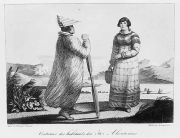Template: Featured article 06 21
The Aleuts (Unangax, Unangan or Unanga) are the indigenous people of the Aleutian Islands of Alaska, United States and Kamchatka Oblast, Russia. They are related to the Inuit and Yupik people. The homeland of the Aleuts includes the Aleutian Islands, the Pribilof Islands, the Shumagin Islands, and the far western part of the Alaskan Peninsula. Anthropologists are not certain of their exact origins (Siberia or Subarctic) but most believe they arrived later than the more southern tribes (around 4,000 years ago). Two cultures developed: the Kodiak (circa 2,500 B.C.E.) and Aleutian (circa 2,000 B.C.E.). [1] They were skilled at hunting and fishing in this harsh climate, skills that were bitterly exploited by Russian fur traders after their arrival around 1750. They received assistance and support from the Russian Orthodox missionaries subsequently and became closely aligned with Orthodox practices and beliefs.
- ↑ H. Pritzker, A Native American Encyclopedia (USA: Oxford Press, 2000 ISBN 0195138775)
